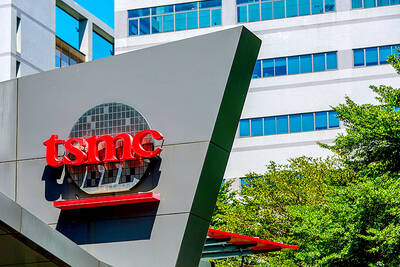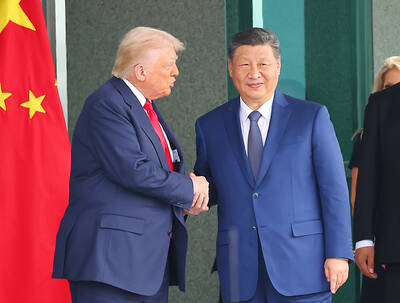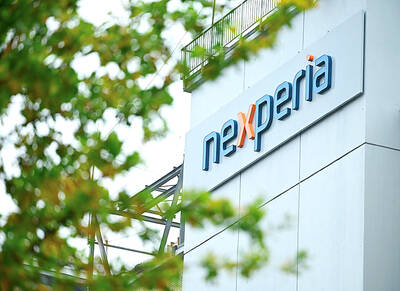The global recession has stalled sales of electronic gadgets but has not crippled the progress of developing new technologies, or reinventing applications of existing technologies.
For example, the use of touch panels is entering a new chapter as a growing number of computer makers introduce new models with screens at least three times larger than a 3.2-inch screen iPhone, allowing users to browse Web pages wirelessly, or to edit photos by clicking, scrolling and zooming with fingers on the screen.
The launch of Microsoft Corp’s next-generation operating system, Windows 7, which is scheduled to hit the market on Oct. 22, gave a crucial push to substitute touch screens for existing displays for computers, said Calvin Hsieh (謝忠利), a Taipei-based analyst with market researcher DisplaySearch.
Taiwan’s major PC brands, such as Acer Inc (宏碁), are presenting their latest all-in-one (AIO) PCs outfitted with touch screens as big as 23 inches at the annual Computex trade show this week in Taipei.
The AIOs are a fusion of computer, TV and a multi-media center. Computer makers believe AIOs will prove popular with consumers seeking to replace their bulky desktop computers.
Almost all new AIO models made by local brands are equipped with a touch panel and run on Windows premium edition and will be able to upgrade to Windows 7 when it becomes available.
“The launch of Microsoft’s Windows 7 will help boost the trend of using touch panels on more handsets, notebooks and netbooks,” said Emma Tang (唐婉倩), an analyst with Daiwa Securities SMBC-Cathay Co (大和國泰), in a report on Tuesday.
“The penetration of touch panels used in notebooks will rise,” she said.
The penetration of touch screen notebooks is expected to triple from 4 percent this year to 12 percent next year and 20 percent in 2011, Tang wrote.
“We think all-in-one PCs will contribute to overall touch panel shipments, but their contribution could be small because such products will mostly sell in the high-end bracket,” Tang said by telephone.
Asustek Computer Inc (華碩), which produced the world’s first low-cost laptops, known as netbooks, has been showing an Eee PC equipped with an 8.9-inch swivel touch screen like a tablet PC during Computex.
Touch screens can also be seen in the firms’s other offerings in AIOs, videophone and smartphones.
Elan Microelectronics Corp (義隆), a chip designer, has jumped on the touch-panel bandwagon by making a capacitive-type ITO film, the screens’ first layer, and touchpad.
Elan chairman Yeh I-hau (葉儀皓) said the company would ship its first multi-touch ITO modules for handset and netbook customers in the second half of this year.
DisplaySearch has forecast that touch panel module shipments may hit 1.39 billion units in 2015, after reaching 468 million units last year, a 52.2 percent increase over the previous year.
However, like the growth of any new products, touch panels for PCs will grow slowly, analysts say.
By 2015, 64 percent of touch panels will be used in mobile phones, Hsieh said.
“I believe notebooks will make a larger contribution to the world’s touch panel industry because we are seeing a growing use of touch trackpads on laptops,” Hsieh said.

RUN IT BACK: A succesful first project working with hyperscalers to design chips encouraged MediaTek to start a second project, aiming to hit stride in 2028 MediaTek Inc (聯發科), the world’s biggest smartphone chip supplier, yesterday said it is engaging a second hyperscaler to help design artificial intelligence (AI) accelerators used in data centers following a similar project expected to generate revenue streams soon. The first AI accelerator project is to bring in US$1 billion revenue next year and several billion US dollars more in 2027, MediaTek chief executive officer Rick Tsai (蔡力行) told a virtual investor conference yesterday. The second AI accelerator project is expected to contribute to revenue beginning in 2028, Tsai said. MediaTek yesterday raised its revenue forecast for the global AI accelerator used

Taiwan Semiconductor Manufacturing Co (TSMC, 台積電) has secured three construction permits for its plan to build a state-of-the-art A14 wafer fab in Taichung, and is likely to start construction soon, the Central Taiwan Science Park Bureau said yesterday. Speaking with CNA, Wang Chun-chieh (王俊傑), deputy director general of the science park bureau, said the world’s largest contract chipmaker has received three construction permits — one to build a fab to roll out sophisticated chips, another to build a central utility plant to provide water and electricity for the facility and the other to build three office buildings. With the three permits, TSMC

TEMPORARY TRUCE: China has made concessions to ease rare earth trade controls, among others, while Washington holds fire on a 100% tariff on all Chinese goods China is effectively suspending implementation of additional export controls on rare earth metals and terminating investigations targeting US companies in the semiconductor supply chain, the White House announced. The White House on Saturday issued a fact sheet outlining some details of the trade pact agreed to earlier in the week by US President Donald Trump and Chinese President Xi Jinping (習近平) that aimed to ease tensions between the world’s two largest economies. Under the deal, China is to issue general licenses valid for exports of rare earths, gallium, germanium, antimony and graphite “for the benefit of US end users and their suppliers

Dutch chipmaker Nexperia BV’s China unit yesterday said that it had established sufficient inventories of finished goods and works-in-progress, and that its supply chain remained secure and stable after its parent halted wafer supplies. The Dutch company suspended supplies of wafers to its Chinese assembly plant a week ago, calling it “a direct consequence of the local management’s recent failure to comply with the agreed contractual payment terms,” Reuters reported on Friday last week. Its China unit called Nexperia’s suspension “unilateral” and “extremely irresponsible,” adding that the Dutch parent’s claim about contractual payment was “misleading and highly deceptive,” according to a statement